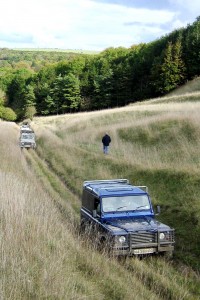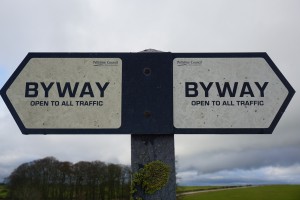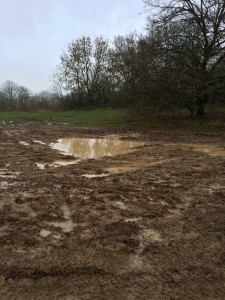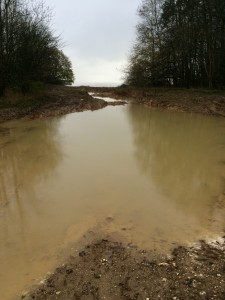- Posts
- 83,310
- Location
- Embasinga stocæ
James Nevitt, 30 November 2015 — Public Access
I’m James Nevitt, I work in DIO’s Environmental Support and Compliance Team (ESC) as their Senior Access and Recreation Adviser, based at Salisbury Plain. You may have seen my earlier blogs on the subject of public access to MOD land.
The MOD has a presumption in favour of public access when land is not in use for military training, and where it’s safe. Members of the public use military land perfectly legally on a daily basis for activities from dog walking to cycling and horse riding to driving.
In fact, members of the public driving on the military estate has been the focus of some of my work lately. Byways open to all traffic, or BOATs, and unclassified roads are a gateway out of urban areas into the countryside. They may be historic droveways, once used for herding cattle to market, or roads that have been in existence for hundreds of years, representing the first means of travel between towns and cities. Fortunately Highway law protects these pieces of history for all to enjoy.

Greenlaners enjoying Salisbury Plain. (Crown Copyright)
Sometimes referred to as greenlanes, hence the term greenlaning, BOATs are often unmade, grass or stone tracks of differing quality. With unpredictable surfaces and reduced directional signing they require varying degrees of skill to safely and successfully navigate.
Salisbury Plain and Greenlaning
Salisbury Plain is regarded as a key location to experience off-road driving. The Salisbury Plain Military Byelaws permits use of roads made up for vehicular purposes when they are not subject to military use. These supplement a network of historical BOATs criss-crossing the iconic, beautiful landscape. The variety of trails provide opportunities for the less experienced to drive on permissive tracks and the more experienced to venture along the “true” green lanes.

A 'Byway Open To All Traffic' sign. [Crown Copyright]
Although the Plain is one of the MOD’s principal military training areas it is an environment that needs to be treated sensitively. At least 50% of Salisbury Plain Training Area is covered by ecological designation because of the wildlife that flourishes in an environment unharmed by modern intensive agriculture. These designations set parameters in which the military can fulfil their training requirements. Due to the sensitive environment, wet weather limits the level of use the MOD can undertake during wet periods.
Rain on the Plain
Unfortunately, these strict restrictions cannot be easily applied to the use of BOATs by the public. Continuing use in wet weather can result in progressive surface damage and erosion. Wanton damage caused to a highway is a criminal offence and can inhibit use of the way by others. Additionally, as a route becomes obstructed by poor conditions, users are forced to divert, which in turn further damages neighbouring land. In my job I regularly see damage caused by inappropriate vehicle use, some of it quite significant.

Wet and muddy ground on Salisbury Plain. [Crown Copyright]
Diverting from proper routes can also be dangerous. In some areas of the Plain leaving marked public rights of way can take users into areas of training estate where they may impact on active military training or place themselves at risk due to the presence of unexploded ordnance. Furthermore this can impact on agricultural land, sensitive habitats, bird nesting and more. Irreparable damage to the highway itself can in some locations be regarded as damaging an historical feature.
Mitigating Damage
As custodians of the Plain the MOD seeks the support of other users in adopting best practice when visiting. The ESC Access and Recreation Team continuously work with key stakeholders to raise awareness, educate, promote good practice and undertake voluntary work on site. As part of my current work I, along with Wiltshire Council, and representatives from the Green Lane Association (GLASS) and the Trail Riders Fellowship (TRF) have identified particularly sensitive BOATs which would be best avoided during the wetter winter months.

A waterlogged track, Salisbury Plain. [Crown Copyright]
Voluntary restraint is to be applied to those routes. This is a means of encouraging users to adopt an alternative route for a temporary period to avoid further damaging the BOAT. Selection of these routes is led by Wiltshire Council, with the input of GLASS and TRF and the support of DIO. Three BOATs will be “closed” under voluntary restraint prior to Christmas and it is hoped that visitors will abide by these requests. Details will be provided by Wiltshire Council. Further routes may be considered in early 2016. By choosing to avoid these routes users will aid their recovery, allowing them to be enjoyed later next year and beyond.
DIO will be providing signs, whilst volunteers, made up of greenlaning group Treadlightly, GLASS, TRF, Wiltshire Council and local enthusiasts, will erect them on site. In addition to supporting this work DIO will be collaborating with Wiltshire Council to deliver some BOAT repairs on Salisbury Plain Training Area in 2016. This will improve the byways for both military and public use.
For further information on Greenlaning Good Practice please download our leaflet at: https://www.gov.uk/government/uploa...le/245198/SPTA_Greenlaning_Practice_Guide.pdf
All content is available under the Open Government Licence v3.0, except where otherwise stated
© Crown copyright
I’m James Nevitt, I work in DIO’s Environmental Support and Compliance Team (ESC) as their Senior Access and Recreation Adviser, based at Salisbury Plain. You may have seen my earlier blogs on the subject of public access to MOD land.
The MOD has a presumption in favour of public access when land is not in use for military training, and where it’s safe. Members of the public use military land perfectly legally on a daily basis for activities from dog walking to cycling and horse riding to driving.
In fact, members of the public driving on the military estate has been the focus of some of my work lately. Byways open to all traffic, or BOATs, and unclassified roads are a gateway out of urban areas into the countryside. They may be historic droveways, once used for herding cattle to market, or roads that have been in existence for hundreds of years, representing the first means of travel between towns and cities. Fortunately Highway law protects these pieces of history for all to enjoy.

Greenlaners enjoying Salisbury Plain. (Crown Copyright)
Sometimes referred to as greenlanes, hence the term greenlaning, BOATs are often unmade, grass or stone tracks of differing quality. With unpredictable surfaces and reduced directional signing they require varying degrees of skill to safely and successfully navigate.
Salisbury Plain and Greenlaning
Salisbury Plain is regarded as a key location to experience off-road driving. The Salisbury Plain Military Byelaws permits use of roads made up for vehicular purposes when they are not subject to military use. These supplement a network of historical BOATs criss-crossing the iconic, beautiful landscape. The variety of trails provide opportunities for the less experienced to drive on permissive tracks and the more experienced to venture along the “true” green lanes.

A 'Byway Open To All Traffic' sign. [Crown Copyright]
Although the Plain is one of the MOD’s principal military training areas it is an environment that needs to be treated sensitively. At least 50% of Salisbury Plain Training Area is covered by ecological designation because of the wildlife that flourishes in an environment unharmed by modern intensive agriculture. These designations set parameters in which the military can fulfil their training requirements. Due to the sensitive environment, wet weather limits the level of use the MOD can undertake during wet periods.
Rain on the Plain
Unfortunately, these strict restrictions cannot be easily applied to the use of BOATs by the public. Continuing use in wet weather can result in progressive surface damage and erosion. Wanton damage caused to a highway is a criminal offence and can inhibit use of the way by others. Additionally, as a route becomes obstructed by poor conditions, users are forced to divert, which in turn further damages neighbouring land. In my job I regularly see damage caused by inappropriate vehicle use, some of it quite significant.

Wet and muddy ground on Salisbury Plain. [Crown Copyright]
Diverting from proper routes can also be dangerous. In some areas of the Plain leaving marked public rights of way can take users into areas of training estate where they may impact on active military training or place themselves at risk due to the presence of unexploded ordnance. Furthermore this can impact on agricultural land, sensitive habitats, bird nesting and more. Irreparable damage to the highway itself can in some locations be regarded as damaging an historical feature.
Mitigating Damage
As custodians of the Plain the MOD seeks the support of other users in adopting best practice when visiting. The ESC Access and Recreation Team continuously work with key stakeholders to raise awareness, educate, promote good practice and undertake voluntary work on site. As part of my current work I, along with Wiltshire Council, and representatives from the Green Lane Association (GLASS) and the Trail Riders Fellowship (TRF) have identified particularly sensitive BOATs which would be best avoided during the wetter winter months.

A waterlogged track, Salisbury Plain. [Crown Copyright]
Voluntary restraint is to be applied to those routes. This is a means of encouraging users to adopt an alternative route for a temporary period to avoid further damaging the BOAT. Selection of these routes is led by Wiltshire Council, with the input of GLASS and TRF and the support of DIO. Three BOATs will be “closed” under voluntary restraint prior to Christmas and it is hoped that visitors will abide by these requests. Details will be provided by Wiltshire Council. Further routes may be considered in early 2016. By choosing to avoid these routes users will aid their recovery, allowing them to be enjoyed later next year and beyond.
DIO will be providing signs, whilst volunteers, made up of greenlaning group Treadlightly, GLASS, TRF, Wiltshire Council and local enthusiasts, will erect them on site. In addition to supporting this work DIO will be collaborating with Wiltshire Council to deliver some BOAT repairs on Salisbury Plain Training Area in 2016. This will improve the byways for both military and public use.
For further information on Greenlaning Good Practice please download our leaflet at: https://www.gov.uk/government/uploa...le/245198/SPTA_Greenlaning_Practice_Guide.pdf
All content is available under the Open Government Licence v3.0, except where otherwise stated
© Crown copyright
